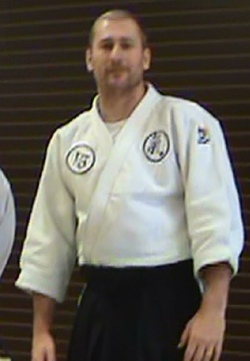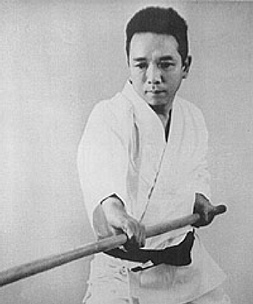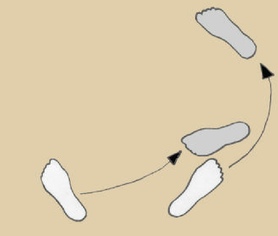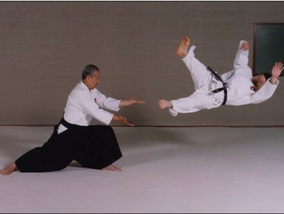



Blending With A Realistic Attack
By Jonathan Wilson
25 February 2015
Over the last couple of days, I have been spending a lot of time watching Tony Annesi and Dan Angier videos on Aiki principles. In one of the videos, Sensei Annesi said something that really caught my attention. In speaking with a group of students on blending and aiki movements, he said, “There is a old Japanese aiki influenced martial proverb that goes like this: ‘Give your attacker some skin ~ just don’t give him any meat.”
Whether or not this is a restatement of an old Japanese proverb or not, I can not say, but I do believe that there is great truth in his statement. You could perhaps even retell the proverb in Western lingo ~ say, “Goldilocks fashion.” ~~~~
“The blend should be not too early, and not too late, but just right.”
Now if you think back on your early blending days as an aikido aficionado, your experience probably fell into one of two categories (if not both categories).
The first blending category could be possibly described as “statuesque” ~ meaning that you just stood there right in front of uke, and relied on your one arm blocks to protect yourself. More than just “late blending,” maybe a better description of this type of blending would simply be “Not Blending.”
The condition of not blending may be a symptom of our learning process which stresses static grip attacks ~ which are ideal for quickly learning basic concepts, but may leave you vulnerable (as a new student) when you try to incorporate those initial concepts with strikes. Thankfully, this condition is quickly and readily identified by the senior student who attacks you a few times as uke, and then simply stops attacking, gives you a once over, and says, “You are not moving out of the way.”
Ahhh the earliest of aikido blending corrections ~ haven’t we all been there?
So, in exercising the inherently good instinct to “not get hit,” you begin taking your movement to heart, and much like the proverbial pendulum swing of a grandfather clock, you swing past the point of equilibrium and overcorrect. Now you have the opposite problem. You are moving too much and too early! For lack of a better descriptive term, I’m calling this second category of bad blending “excessive blending” or maybe “Hyper Blending.”
Excessive Blending or Hyper Blending can take on a couple of different forms, but it will most often look like a simple “side step” where nage simply slides his body 1 - 2 feet to the left or right with limited or even no reorientation to uke. Generally speaking, the Hyper Blending uke loses all relationship to uke, and it is all to common. I’ve seen degrees of this approach taken by students with belts of all colors, and sadly even witnessed it a few times on my own attack line for sho-dan (why oh why did I video tape that test???? ~~~ Answer: Because I’m a student of my own abilities, and I want to do it right!).
Now back on course, the Hyper Blend, while not ideal, does have some intrinsic, albeit basic, benefits relative to no blending at all. If you are a Hyper Blender, you WILL successfully avoid the strike, BUT the predictable result of the hyper blend is that you have moved so far out of the way without any orientation to uke, that you forfeit any potential connection with your attacker (meaning you can not control him), and after missing you with his first strike, uke simply turns, and takes a more deliberate striking posture on his next attempt to hit you ~~ making your next blend even tougher, because your uke is now more cautious in his striking.
If you’re honest, you’ve probably experienced both of these conditions at some point in your early career as a student. In my first visit to the Nutley Dojo (as a Purple Belt), I covered both bad blending extremes in a 20 minute period. In a single attack line I went from following these instructions: “Grab your obi (belt) with both hands” and don’t get hit” to “Delay your blend as long as you can, and try to blend so late that uke’s fist gets caught in your gi jacket.”
Sensei Durand gave me my first assignment due to my unwitting statuesque approach. His second assignment was due to my own predictable over correction and hyper blending.
Of course, proper blending was taught in my home dojo, but I got to a point in my training where I was “thinking too much” about what technique I would use as I was being attacked, and simply began to stand there like a deer staring into a set of headlights on the roadside when uke attacked.
In fact, Sensei John Carter (in the Lexington, SC dojo where I train), teaches every new student the First Wrist Technique (Nikyo) before anything else. To me, it makes perfect sense. The most common attack is a wrist grab, and The First Wrist Technique works wonderfully against a cross grab, and nage’s hand movement can be easily modified to make it work against a straight grab, sleeve grab, etc.
That said, the First Wrist Technique also incorporates core elements of the basic blending footwork the student will utilize over the life of their martial experience. In thinking on it, I think I like the idea that the footwork of the First Wrist Technique could be called, “The First Blend” ~ in which you enter slightly (disrupting uke’s space), and then swing the back foot around about 45 degrees with your hips (moving you just off line).
Now, once you get the basic principle under your belt, you seem to naturally get better and better at blending, and then you begin to realize that you need less and less actual movement to “just barely get out the way.”
As you begin to approach mastery, it seems to work like this: when you enter into the right position at just the right time (by ‘giving your attacker some skin ~ but no meat”), uke’s balance will be disrupted by your unexpected presence in his space, and muscle free, powerful, aikido technique will simply fall into your lap at that point. Your aikido will look different, and casual observers might begin to think that your uke is “simply falling down on purpose” rather than being thrown by some technique you’ve employed.
What say ye?
Want to add to the discussion? Post your comments in the comment box below!

2014 - 2021 ngaexperience.com

A close approximation to “the First Blend” ~~~ the footwork for the First Wrist Technique.

This Nage has clearly disrupted his uke’s balance, and powerful, muscle free, technique followed. Also, note how the extended hamni is utilized to maximize nage’s projection capabilities.
Master Nara says, “Learn to blend properly, and I’ll stop hitting you with my Jo staff.”


Not our style, but the Irimi (entering motion) is similar (although somewhat linear in this instance). Note how close Nage’s body is to Uke’s intended strike. This is a close approximation of Sensei Annesi’s proverb... The blend gives up a little skin, but no meat.

